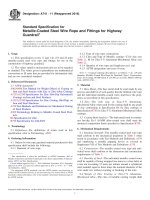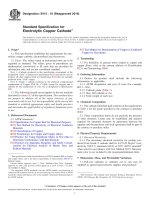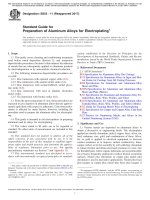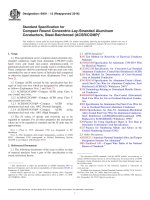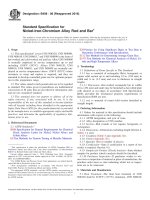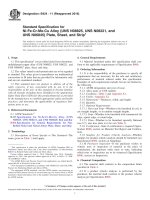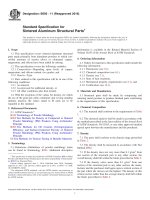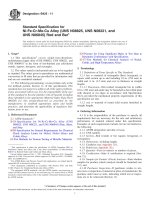Astm b 226 11 (2016)
Bạn đang xem bản rút gọn của tài liệu. Xem và tải ngay bản đầy đủ của tài liệu tại đây (99.75 KB, 4 trang )
Designation: B226 − 11 (Reapproved 2016)
Standard Specification for
Cored, Annular, Concentric-Lay-Stranded Copper
Conductors1
This standard is issued under the fixed designation B226; the number immediately following the designation indicates the year of
original adoption or, in the case of revision, the year of last revision. A number in parentheses indicates the year of last reapproval. A
superscript epsilon (´) indicates an editorial change since the last revision or reapproval.
1. Scope
Wire for Electrical Purposes
B172 Specification for Rope-Lay-Stranded Copper Conductors Having Bunch-Stranded Members, for Electrical Conductors
B173 Specification for Rope-Lay-Stranded Copper Conductors Having Concentric-Stranded Members, for Electrical
Conductors
B174 Specification for Bunch-Stranded Copper Conductors
for Electrical Conductors
B263 Test Method for Determination of Cross-Sectional
Area of Stranded Conductors
B354 Terminology Relating to Uninsulated Metallic Electrical Conductors
B496 Specification for Compact Round Concentric-LayStranded Copper Conductors
B784 Specification for Modified Concentric-Lay-Stranded
Copper Conductors for Use in Insulated Electrical Cables
B787/B787M Specification for 19 Wire Combination
Unilay-Stranded Copper Conductors for Subsequent Insulation
B835 Specification for Compact Round Stranded Copper
Conductors Using Single Input Wire Construction
B902 Specification for Compressed Round Stranded Copper
Conductors, Hard, Medium-Hard, or Soft Using Single
Input Wire Construction
2.3 American National Standard:
IEEE Standard 100 The Authoritative Dictionary of IEEE
Standards Terms3
2.4 NIST:
NBS Handbook 100—Copper Wire Tables4
1.1 This specification covers cored, annular, concentric-laystranded conductors made from round soft copper wires, either
uncoated or coated with tin for use as electrical conductors
(Explanatory Note 1 and Note 2).
1.2 The constructions prescribed herein are suitable for bare
conductors, or for conductors to be covered with weatherresistant (weather-proof) material, or for conductors to be
insulated with rubber, varnished cloth, or impregnated paper,
except types such as “oil-filled” or “gas-filled” (Explanatory
Note 3).
1.3 Cored, annular conductor constructions not included in
this specification shall be specifically agreed upon between the
manufacturer and the purchaser when placing the order.
1.4 These constructions are not recommended for use as
electric furnace leads where great flexibility is required and
special conductor designs are indicated in consideration of the
particular service requirements.
1.5 The SI values for density are regarded as the standard.
For all other properties the inch-pound values are to be
regarded as standard and the SI units may be approximate.
2. Referenced Documents
2.1 The following documents in effect at the time of
reference form a part of these methods to the extent referenced
herein:
2.2 ASTM Standards:2
B3 Specification for Soft or Annealed Copper Wire
B8 Specification for Concentric-Lay-Stranded Copper
Conductors, Hard, Medium-Hard, or Soft
B33 Specification for Tin-Coated Soft or Annealed Copper
3. Ordering Information
3.1 Orders for material under this specification shall include
the following information:
3.1.1 Quantity of each size,
3.1.2 Conductor size: circular-mil area (Section 7 and Table
1),
1
This specification is under the jurisdiction of ASTM Committee B01 on
Electrical Conductors and is the direct responsibility of Subcommittee B01.04 on
Conductors of Copper and Copper Alloys.
Current edition approved Oct. 1, 2016. Published October 2016. Originally
approved in 1948. Last previous edition approved in 2011 as B226 – 11. DOI:
10.1520/B0226-11R16.
2
For referenced ASTM standards, visit the ASTM website, www.astm.org, or
contact ASTM Customer Service at For Annual Book of ASTM
Standards volume information, refer to the standard’s Document Summary page on
the ASTM website.
3
Available from American National Standards Institute (ANSI), 25 W. 43rd St.,
4th Floor, New York, NY 10036, .
4
Available from National Technical Information Service (NTIS), 5301 Shawnee
Rd., Alexandria, VA 22312, .
Copyright © ASTM International, 100 Barr Harbor Drive, PO Box C700, West Conshohocken, PA 19428-2959. United States
1
B226 − 11 (2016)
TABLE 1 Construction of Cored, Annular, Concentric-Lay-Stranded Copper Conductors
Nominal Area of
Copper
Cross
Section, cmils
Approximate
Diameter of
Core, in.
Diameter of
Wires, in.
5 000 000
4 500 000
2.875
2.500
4 000 000
3 500 000
3 000 000
A
Number of Strands in Layers
1st
2nd
3rd
Total
Calculated Area of
Copper, Cross
Section, cmils
Maximum
Outside Diameter,A
in.
0.1620
0.1620
57
50
63
56
69
62
189
168
4 960 116
4 408 992
3.897
3.517
2.250
2.000
1.625
0.1620
0.1620
0.1620
45
40
33
51
45
38
57
52
45
153
137
116
4 015 332
3 595 428
3 044 304
3.262
3.007
2.627
2 500 000
2 000 000
1 750 000
1.500
1.313
1.125
0.1440
0.1284
0.1280
34
34
30
40
40
35
46
46
42
120
120
107
2 488 320
1 978 387
1 753 088
2.394
2.114
1.923
1 500 000
1 250 000
1 000 000
1.000
0.750
0.563
0.1255
0.1255
0.1255
26
21
16
32
26
21
38
33
28
96
80
65
1 512 024
1 260 020
1 023 766
1.783
1.533
1.346
900 000
800 000
750 000
0.500
0.468
0.375
0.1172
0.1110
0.1172
16
16
12
22
21
18
28
28
24
66
65
54
906 565
800 865
741 735
1.234
1.164
1.108
The following plus tolerances are included in the calculation of maximum outside diameters:
Nominal Area,
Plus Tolerance Included,
cmils
mils
5 000 000 to 4 500 001
50
4 500 000 to 4 000 001
45
4 000 000 to 3 500 001
40
3 500 000 to 3 000 001
35
3 000 000 to 750 000
30
5. Joints
3.1.3 Whether coated or uncoated; if coated, a tin coating
only (Section 11),
3.1.4 Specific kind and treatment of core material (Section
4),
3.1.5 Details of special-purpose lays, if required (see 6.1
and 6.2 and Explanatory Note 3),
3.1.6 Package size (Section 14),
3.1.7 Lagging, if required (see 14.2),
3.1.8 Special package marking, if required (Section 14.3),
and
3.1.9 Place of inspection (Section 13).
5.1 No splice shall be made in the conductor as a whole.
Welds or brazes may be made in the finished individual wires.
Not more than one of the wires in any given layer shall be
spliced in any 1-ft length of that layer.
5.2 All joints shall be made in a workmanlike manner and
shall be approximately the diameter of the unjointed wire.
6. Lay
4. Core
6.1 The length of lay of the respective layers of wires shall
be at the option of the manufacturer unless otherwise agreed
upon with the purchaser (Explanatory Note 3).
4.1 The core may be of any material or materials suitable for
the purpose as agreed upon by the manufacturer and the
purchaser when placing the order.
6.2 The direction of lay of the outer layer of wires shall be
left hand, unless specified otherwise by the purchaser (Explanatory Note 3).
4.2 The size of the core and its surface firmness as a base for
the overlaid wires shall be adequate to prevent the forcing or
dropping of any wire out of its layer position (Explanatory
Note 4).
6.3 The direction of lay shall be reversed in successive
layers (Explanatory Note 3).
7. Construction
7.1 The nominal conductor size, number of layers of wires,
number, diameter, lay-up of wires, approximate core diameter,
and maximum conductor diameter shall conform to the requirements prescribed in Table 1 (Explanatory Note 4).
4.3 If a specific kind of fibrous core is required by the
purchaser (such as manila rope, sisal, and so forth) it shall be
specified by him when placing the order (Explanatory Note 4).
4.4 The proper treatment of the fibrous core, if any treatment be required, shall be left to the discretion of the
manufacturer unless other arrangements are made at the time of
purchase.
8. Physical and Electrical Tests
8.1 Tests for the electrical properties of wires composing
conductors made from soft or annealed copper wire, bare or
coated, shall be made before stranding.
4.5 If a metal supporting type of core is required, special
arrangements will be necessary between the manufacturer and
the purchaser.
8.2 Tests for the physical properties of soft or annealed
copper wire, bare or coated, may be made upon the wires
2
B226 − 11 (2016)
TABLE 3 Approximate Areas and Linear Densities of Cored,
Annular, Concentric Lay-Stranded Copper Conductors
before stranding or upon wires removed from the completed
stranded conductor, but need not be made upon both. Care shall
be taken to avoid mechanical injury to wire removed from the
conductor for the purpose of testing.
Nominal Size,
cmils
8.3 The physical properties of wire when tested before
stranding shall conform to the applicable requirements of 11.2.
8.4 The physical properties of wires removed from the
completed stranded conductor shall be permitted to vary from
the applicable requirements of 11.2 by the following amounts
(Explanatory Note 5):
8.4.1 Average of Results Obtained on All Wires Tested—The
minimum elongation required shall be reduced in numerical
value 5 (for example, from 30 to 25 %) from the numerical
requirements for the wire before stranding.
8.4.2 Results Obtained on Individual Wires—The elongation
of individual wires shall be reduced in numerical value 15 from
the minimum requirements before stranding (that is, 10 in
addition to the 5 allowed in 8.4.1) but in no case shall the
elongation of any individual wire be less than 5 %.
Calculated
Calculated Mass per Unit Length, lb/1000 ft
Area of Copper
Cross Section,
Copper
CoreA
Total
in.2
5 000 000
4 500 000
3.896
3.463
15 760
14 010
2926
2213
18 690
16 220
4 000 000
3 500 000
3 000 000
3.154
2.823
2.391
12 640
11 320
9 492
1792
1416
935
14 430
12 740
10 430
2 500 000
2 000 000
1 750 000
1.954
1.554
1.377
7 758
6 168
5 466
797
610
448
1 500 000
1 250 000
1 000 000
1.188
0.9896
0.8041
4 714
3 928
3 192
900 000
800 000
750 000
0.7120
0.6290
0.5826
2 826
2 497
2 312
354
199
112
79
78
50
8
6
5
5
4
3
555
778
914
068
127
304
2 905
2 575
2 362
A
Impregnated manila rope core assumed (see 4.3). For dry core 20 percent
should be deducted from these tabular values of weights of cores, with corresponding changes in total weights (Explanatory Note 4).
8.5 In the event that the requirements prescribed in 8.4.2 are
met but those prescribed in 8.4.1 are not met, a retest shall be
permitted wherein all wires of the conductor shall be tested for
the purpose of final determination of conformance to 8.4.
8.6 Elongation tests to determine compliance shall not be
made on the conductor as a unit.
11.2 Before stranding, the copper wire used shall meet all of
the requirements of the following specifications that are
applicable to its type: Specifications B3 and B33.
8.7 If a tin coating test is required, it shall be made on wires
prior to stranding.
12. Variation in Area
12.1 The area of the copper cross-section of the completed
conductor shall be not less than 98 % of the calculated area
given in Table 1. The area of cross section of a conductor shall
be considered to be the sum of the cross-sectional areas of its
component wires at any section when measured perpendicularly to their individual axes. Alternatively, the cross-section of
a conductor may be calculated by the weight method as
specified in Test Method B263. In case of dispute, Test Method
B263 shall be the referee.
9. Density
9.1 For the purpose of calculating mass, cross-sections, and
so forth, the density of copper shall be taken as 0.32117
lb/in.3 (8.89 g/cm3) at 20°C (Explanatory Note 6).
10. Mass
10.1 The mass per unit length and electrical resistance of a
unit length of stranded conductor are a function of the length of
lay. The approximate mass per unit length and electrical
resistance may be determined using the standard increments
shown in Table 2. When greater accuracy is desired, the
increment based on the specific lay of the conductor may be
calculated (Explanatory Note 7).
13. Inspection
13.1 All tests and inspection shall be made at the place of
manufacture, unless otherwise especially agreed upon between
the manufacturer and the purchaser at the time of purchase. The
manufacturer shall afford the inspector representing the purchaser all reasonable facilities, to satisfy him that the material
is being furnished in accordance with this specification.
10.2 The approximate mass per unit length of completed
conductors are given in Table 3 for information only, and
include mass per unit lengths of core calculated on the basis of
437 lb/in.2·1000 ft, using approximate core areas.
14. Packaging and Package Marking
11. Requirements for Wires
14.1 Package sizes for conductors shall be agreed upon
between the manufacturer and the purchaser in the placing of
individual orders.
11.1 The purchaser shall designate if the type of wire is tin
coated, or not (see section 11.2).
14.2 The conductors shall be protected against damage in
ordinary handling and shipping. If heavy wood lagging is
required, it shall be specified by the purchaser at the time of
placing the order.
TABLE 2 Standard Increments Due to Stranding
Nominal Area of Copper Cross
Section, cmils
Increment (Increase)
in Mass per Unit Length of
Copper Cross Section, %
5 000 000 to 4 000 001
4 000 000 to 3 000 001
3 000 000 to 750 000
5
4
3
14.3 The net mass, length (or lengths, if more than one
length is included in the package), size, kind of conductor,
purchase order number, reel number, and any other markings
3
B226 − 11 (2016)
15. Keywords
required by the purchase order shall be marked on a tag
attached to the end of the conductor inside the package. The
same information, together with the manufacturer’s serial
number (if any) and all shipping marks required by the
purchaser, shall appear on the outside of each package.
15.1 annular; concentric-lay-stranded; concentric-lay
stranded copper conductor; copper electrical conductor; cored;
electrical conductor; electrical conductor–copper; stranded
copper conductor
EXPLANATORY NOTES
of density of hard-drawn and annealed copper wire. In calculations
involving density it must be borne in mind that the apparent density of
coated wire is not constant but a variable function of wire diameter. The
smaller the diameter, the greater the percentage of coating present and
hence the greater departure from the density of copper.
NOTE 7—The increment of linear density or electrical resistance of a
completed concentric-lay-stranded conductor (k) in percent is
NOTE 1—In this specification cored, annular, concentric-lay-stranded
conductor constructions only are specifically designated. Requirements
for non-cored constructions will be found in the following specifications:
Specifications B8, B172, B173, B174, B496, B784, B787/B787M, B835,
and B902.
NOTE 2—For definitions of terms relating to conductors, reference
should be made to IEEE Standard 100 and Terminology B354.
NOTE 3—If service applications for conductors of this type are unusual
as to flexibility requirements, variation in the construction may be
desirable. Details concerning such should be arranged between the
manufacturer and the purchaser at the time of placing the order.
NOTE 4—Fiber cores are available in commercial sizes. It has been
found impracticable to prescribe fiber cores made to special diameters. It
is permissible for the manufacturer to use a fiber core which is slightly
oversize or to build up a slightly undersized core with servings of suitable
material to bring it up to the diameter required for compliance with 4.2.
NOTE 5—Wires unlaid from conductors manifestly will have different
physical properties from those of the wires when prepared for cabling, on
account of the deformation brought about by laying and again straightening for test.
NOTE 6—The value of density of copper is in accordance with the
International Annealed Copper Standard. The corresponding value at 0°C
is 8.90 g/cm3 (0.32150 lb/in.3). As pointed out in the discussion of this
subject in NBS Handbook 100, there is no appreciable difference in values
k 5 100 ~ m 2 1 !
where m is the stranding factor, and is the ratio of the mass or electrical
resistance of a unit length of stranded conductor to that of a solid
conductor of the same cross-sectional area or of a stranded conductor with
infinite length of lay, that is, all wires parallel to the conductor axis. The
stranding factor m for the completed stranded conductor is the numerical
average of the lay factors for each of the individual wires in the conductor,
including the straight core wire, if any (for which the stranding factor is
unity). The stranding factor (mind) for any given wire in a concentric-laystranded conductor is
m ind 5 =11 ~ 9.8696/n 2 !
where:
n = length of lay/diameter of helical path of the wire.
The derivation of the above is given in NBS Handbook 100.
ASTM International takes no position respecting the validity of any patent rights asserted in connection with any item mentioned
in this standard. Users of this standard are expressly advised that determination of the validity of any such patent rights, and the risk
of infringement of such rights, are entirely their own responsibility.
This standard is subject to revision at any time by the responsible technical committee and must be reviewed every five years and
if not revised, either reapproved or withdrawn. Your comments are invited either for revision of this standard or for additional standards
and should be addressed to ASTM International Headquarters. Your comments will receive careful consideration at a meeting of the
responsible technical committee, which you may attend. If you feel that your comments have not received a fair hearing you should
make your views known to the ASTM Committee on Standards, at the address shown below.
This standard is copyrighted by ASTM International, 100 Barr Harbor Drive, PO Box C700, West Conshohocken, PA 19428-2959,
United States. Individual reprints (single or multiple copies) of this standard may be obtained by contacting ASTM at the above
address or at 610-832-9585 (phone), 610-832-9555 (fax), or (e-mail); or through the ASTM website
(www.astm.org). Permission rights to photocopy the standard may also be secured from the Copyright Clearance Center, 222
Rosewood Drive, Danvers, MA 01923, Tel: (978) 646-2600; />
4
